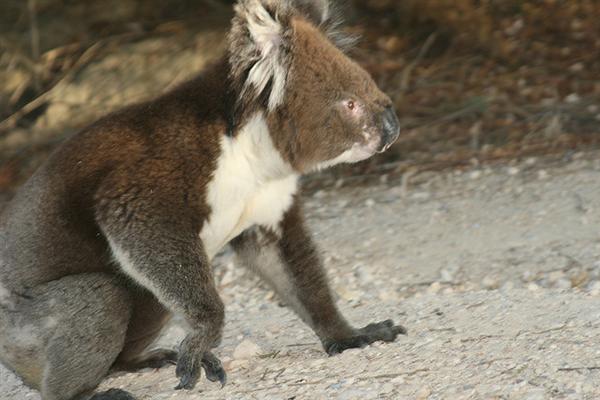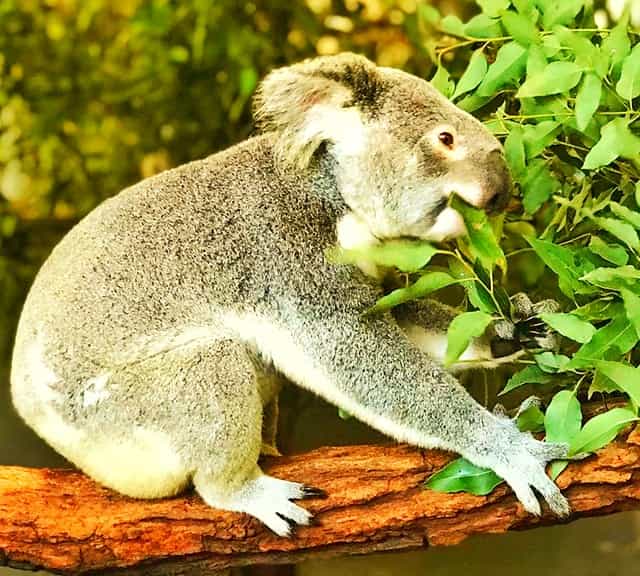Koalas Tooth Decay through its Abrasive Diet
Tooth-decaying is one of the most common occurrences within koalas and their abrasive diet is chiefly responsible for it. Koalas are primarily dependent on the Eucalyptus leaves as part of their diet. These leaves are so much abrasive and hard for the koalas' tooth that their loss and decaying become the ultimate outcome after its continuous consumption (entire lifespan).
The koalas' diet (the eucalyptus leaves) is so hard and abrasive that it is primarily responsible for tooth-decaying within koalas.
Sadly; there are no other alternatives for koalas and they only have to eat more and more Eucalyptus leaves. Apart from being abrasive, the Eucalyptus leaves contain poisonous and acidic compounds which are also responsible for tooth decaying within koalas. Let's have a profound analysis of koalas' diet (the Eucalyptus leaves) and its impact on tooth-decaying problems within koalas.


Remember; koalas are not always vulnerable to tooth-decaying throughout their lives. Tooth-decaying develops with the passage of time and almost all koalas always have to suffer from tooth-decaying within their lifespan. This means that young and the adult koalas within their prime do not suffer from any tooth-loss or tooth-decaying while the older koalas usually suffer from tooth-decay.
Tooth-decaying is hardly an issue for the younger and adult koalas in their prime. However; tooth-decaying start occurring within older koalas and it continues to increase with the passage of time.
Once the process of tooth-decaying starts within koalas, it continues to increase as koalas have to eat more and more Eucalyptus leaves to fulfill their energy requirements. This is the key reason that the older koalas consume 41% more Eucalyptus leaves as compared to the younger koalas. Remember; only finely chewed food particles release energy for koalas during the process of digestion while bigger leaves are passed on for excretion.


When koalas chew the Eucalyptus leaves, the leaves rub as sand paper against their teeth and with the passage of time (in the older age), the koalas' teeth get worn down. Even a stage comes within the lives of koalas that their teeth are worn down to stumps and their chewing ability is almost gone.
Eucalyptus leaves act like sand paper for koalas while chewing. This keeps on reducing koalas' teeth and worn them down to stumps.
A koala with worn down teeth is unable to chew properly and convert any Eucalyptus foliage into finely chewed contents. This is where the starvation issue prevails within koalas and they become weaker and weaker and finally die because of lack of energy within their bodies.


Even worst; koalas have to rechew their food to have them converted into finely chewed particles for better digestion and energy extraction from the Eucalyptus leaves. This process is also almost similar to rumination within other herbivores. Koalas store finely chewed food within their hindgut for the extraction of energy through the process of fermentation.
The impact of koalas' abrasive diet doubles, when koalas have to rechew or regurgitate the Eucalyptus leaves during the process of Merycism.
This process is called Merycism within koalas as they tend to regurgitate the food from their stomach for proper digestion. The Regurgitating of food (always the Eucalyptus leaves) also severely impacts the wear and tear of their teeth which ultimately results in tooth-decaying within koalas in the older age.


Apart from being abrasive, the Eucalyptus leaves in general are not good for teeth when eaten directly. Even though small doses of the Eucalyptus oils have been used to remove harmful bacteria from teeth but their direct chewing have been known to adversely impact the teeth. Eucalyptus leaves contain a lot of compounds which can result in tooth-decaying of the other animals.
Presence of the strong oils and compounds within the Eucalyptus leaves have the ability to severely impact the teeth of older koalas.
However; the young koalas have the natural ability to compensate the adverse effects of the Eucalyptus leaves. On the other hand; older koalas are not fortunate to have this luxury and they suffer from teeth-decaying at the ending lifecycle of their lives.


Lastly; despite eating the Eucalyptus leaves which are very abrasive, poisonous, lower in energy and very bad for teeth, koalas surprisingly maintain a reasonable lifespan of 13 years on average. Furthermore; their tooth decaying only gets worst during the last few years of their lives.
Surprisingly; despite having abrasive diet, koalas still maintain a reasonable lifespan of 13 years on average. Over the span of millions of years koalas have perfectly adapted themselves against the Eucalyptus leaves.
This also means that koalas have the natural ability to compensate the damage of the Eucalyptus leaves on their teeth. Remember koalas are living on Eucalyptus leaves for millions of years. Their survival by living on abrasive diet also shows their unique adaptability.

Liger Articles
Marsupials vs. Placental Mammals
Koalas are most popular animals in Australia
Koalas are more popular as compared to Kangaroos
Koalas and their Dominant Nose
Button Shaped Fascinating Eyes of the Koalas
Core Recognizing Features of Koalas
Koalas are the largest tree climbing Mammals in Australia - Koalas as Arboreal
Sizes of Koalas from Queensland, Australia
Sizes of Koalas from Australia's Victorian Origin
Difference between Queensland and Victorian Koalas
Average Weights of Male Koalas
Weighing Male vs Female Koalas
Male Koalas have Loudest of voice among all Australian Mammals
Origin of Koalas & their Evolution
Koalas Population Increased at the end of 20th century
Historical Evolution of the Koalas - A Physical Perspective
Koalas and their Aboriginal and Native Names
It Took 10 years for Aboriginal Australians to Spot and Recognize Koalas
Koalas Live Hardest and Toughest Lives Among all animals
Koalas Tooth Decay through its Abrasive Diet
Koalas Diet is Fully Poisonous and Toxic
Koalas' Food Eucalyptus has Lower Nutrition
Koalas have Lower Energy Levels
Koalas - When Occasionally Spotted on other Leaves for their Food
Why Koalas drink little or no Water?
Koalas & their Advanced Digestive Mechanisms
Why Koalas Sleep more than 20 Hours a Day?
Koalas Lack Energy and Strength
Koala's Tooth from Growth till Tooth Decay
Young Koalas are Better Chewers as Compared to Mature and Elderly Koalas
Why Most Koalas Die of Starvation?
Heat Exhaustion and Heat Strokes among Koalas
Do Koalas lack Intellectual Abilities?
Koalas and their Sense of Smell
Koalas Love Fresh Eucalyptus Leaves as their Food
Koalas' Eucalyptus Leaves' Preferences during summers and Winters
Koalas' Preference for Leaves Having Higher Nitrogen Levels
Koalas Prefer Big Eucalyptus Trees and Love to Stay at Trees' tops.
Koalas Prefer to Live in Areas that have Good Soil and Fertile Lands
Koalas' Per Day Food Consumption
Koalas Food Consumption Depends upon their Body Size
Lactating Female Koalas Consume More Food as Compared to the Normal Female Koalas
Koalas Consume More Food during Winters as Compared to Summers
Female Koalas are very Selective Regarding their Leaf Selection and Food Consumption.
A Baby Koala Joey Lives in her Mother's Pouch for 8 to 9 Months
Gestation Period within Female Koalas
Breeding Behaviors of the Female Koalas
The Size of the Baby Koala Joey at the time of its Birth
Weight of the Baby Koala Joey at the Time of its Birth
At Birth the Baby Koala Joey Travels from Cloaca into their Mother's Pouch
Newborn Koala Joeys have Well-Established Sense of Smell
Koala Joey keeps his Head Inside its Mother's Pouch for 6 Months
Complete Shape and Body Development of the Koala Joey
Pap - The first solid food of the Koala Joeys
When Does Tooth Emerge for Baby Koala Joey?
Aggressive Behavior of Mother Koalas towards their Joeys
Queensland Offers Less Nutritional Values for Koalas
How long does Koalas live? Age of the Koala
Female Koalas Live More than Male Koalas
What is the Average Age of the Male Koala?
Average Ages of the Female Koalas
For How Long a Female Koala can Give Birth to the Koala Joeys?
How many times female Koalas give birth?
Koalas and Australia's Bushfire
Koalas' fur quickly gets rid of rain water
Koalas Resting and Sleeping Postures and Positions during the Hot Summer Seasons
Winter Season and Sleeping Postures of Koalas
Koalas' Urination during Summer and Winter Seasons
Koalas and their Specialized Claws
How does a Koala regulate its Body Temperature?
Food Consumption and Feeding Timings of the Koalas
Koalas Always Prefer Eucalyptus Leaves from the Tree top
How does a Koala Grooms itself?
Koalas' Territories and ranges within Australia's Victorian Areas
Koalas' Territories and Ranges within Australia's Queensland Areas
Behavior of the Alpha Dominant Male Koala
Aggressiveness of Female Koalas
Scent Marking Behavior of the Male Koalas
Mating Strategy of the Male Koalas
Fights and Territorial Encounters of Male Koalas
Sounds and Vocalizations of Male Koalas
Sounds and Vocalization of the Female Koalas
Koalas and their Facial Expressions
Breeding Ages of the Male and Female Koalas
Factors Influencing the Success of Koalas' Fertility Rates
Behavior of the young and adolescent Koala Joey
When Does a Mother Koala Says Goodbye and Leaves the Young Koala Joey?
Playful Behavior of the Young Koala Joeys
Koalas - Mating Season and Mating Months
Koala Informationen, Bilder, Neuigkeit, und Erforschung
Коала - сумчатый млекопитающий